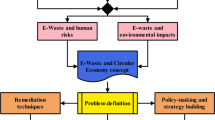Abstract
The impact of appropriate E-waste management practices on the environment, human health, and natural resources has made E-waste management an interesting research topic in recent decades. Research also shows that government intervention is an important factor in controlling the emission volume produced by waste management systems. This study considers a base E-waste supply chain in which a collection center is responsible for collecting E-waste and delivering it to a recycling center. The recycling center recovers valuable material and sells it to electronic device manufacturing companies using a price/sustainability-sensitive demand. E-waste material recovery generates emissions that are undesirable for manufacturing companies. Two extended cases regarding the base supply chain are studied, as well: (1) the recycling center is also active in E-waste collection. (2) There are two active recycling centers. Although the sustainability-sensitive demand is a controlling factor for material recovery emissions, government interferences through tariff and emission penalties make sure that sustainable issues are considered in the material recovery process. Each plant in this study makes a marginal profit by processing E-waste; therefore, it is important to know which plant is the primary decision-maker when it comes to price. Because of its capability in terms of solving interactive decision-making problems, game theory is used to model different scenarios in our problem. Equilibrium values are derived, and a numerical example with parameter sensitivity analysis is provided to show the applicability of the proposed models. The results show that the E-waste supply chain makes more profit and selects a higher level of material recovery sustainability if the plants work under a centralized decision-making framework. Moreover, it is more profitable for the entire E-waste supply chain if the recycling center undertakes a portion of the E-waste collection activity.








Similar content being viewed by others
References
Dias P, Bernardes AM, Huda N (2018) Waste electrical and electronic equipment (WEEE) management: an analysis on the australian e-waste recycling scheme. J Clean Prod 197:750–764
Garlapati VK (2016) E-waste in India and developed countries: management, recycling, business and biotechnological initiatives. Renew Sustain Energy Rev 54:874–881
Babayemi JO, Osibanjo O, Weber R (2017) Material and substance flow analysis of mobile phones in Nigeria: a step for progressing e-waste management strategy. J Mater Cycles Waste Manag 19(2):731–742
de Souza RG, Clímaco JCN, Sant’Anna AP, Rocha TB, do Valle RAB, Quelhas OLG (2016) Sustainability assessment and prioritisation of e-waste management options in Brazil. Waste Manag 57:46–56
Rajarao R, Sahajwalla V, Cayumil R, Park M, Khanna R (2014) Novel approach for processing hazardous electronic waste. Proc Environ Sci 21:33–41
Chen J, Hua C, Liu C (2019) Considerations for better construction and demolition waste management: identifying the decision behaviors of contractors and government departments through a game theory decision-making model. J Clean Prod 212:190–199
Bhaskar K, Turaga RMR (2018) India’s e-waste rules and their impact on e-waste management practices: a case study. J Ind Ecol 22(4):930–942
Fumao YU (2012) The effect of situational factors on the relationship between behavior and it’s influence factors for recycling of electronic waste & appliances. Ecol Econ 2:1
Ylä-Mella J, Keiski RL, Pongrácz E (2015) Electronic waste recovery in Finland: consumers’ perceptions towards recycling and re-use of mobile phones. Waste Manag 45:374–384
Zheng B, Yang C, Yang J, Zhang M (2017) Pricing, collecting and contract design in a reverse supply chain with incomplete information. Comput Ind Eng 111:109–122
Milovantseva N, Saphores J-D (2013) E-waste bans and US households’ preferences for disposing of their e-waste. J Environ Manag 124:8–16
Kasper AC, Gabriel AP, de Oliveira ELB, de Freitas Juchneski NC, Veit HM (2015) Electronic waste recycling. Electronic waste. Springer, New York, pp 87–127
Öztürk T (2015) Generation and management of electrical–electronic waste (e-waste) in Turkey. J Mater Cycles Waste Manag 17(3):411–421
Ikhlayel M (2018) An integrated approach to establish e-waste management systems for developing countries. J Clean Prod 170:119–130
Lu C et al (2015) An overview of e-waste management in China. J Mater Cycles Waste Manag 17(1):1–12
Vadoudi K, Kim J, Laratte B, Lee S-J, Troussier N (2015) E-waste management and resources recovery in France. Waste Manag Res 33(10):919–929
Ilankoon I, Ghorbani Y, Chong MN, Herath G, Moyo T, Petersen J (2018) E-waste in the international context—a review of trade flows, regulations, hazards, waste management strategies and technologies for value recovery. Waste Manag 82:258–275
Kell D (2009) Recycling and recovery. Electron Waste Manag R Soc Chem 13:91–110
Mohammadi M, Jämsä-Jounela S-L, Harjunkoski I (2019) Optimal planning of municipal solid waste management systems in an integrated supply chain network. Comput Chem Eng 123:155–169
Jayaraman K, Vejayon S, Raman S, Mostafiz I (2019) The proposed e-waste management model from the conviction of individual laptop disposal practices—an empirical study in Malaysia. J Clean Prod 208:688–696
Myerson RB (2013) Game theory. Harvard University Press, Harvard
Ghalehkhondabi I, Maihami R (2019) Price decision making in a centralized/decentralized solid waste disposal supply chain with one contractor and two disposal facilities. In: IFIP international conference on advances in production management systems, pp 17–26
Sabbaghi M, Behdad S, Zhuang J (2016) Managing consumer behavior toward on-time return of the waste electrical and electronic equipment: a game theoretic approach. Int J Prod Econ 182:545–563
Guo L, Qu Y, Tseng M-L, Wu C, Wang X (2018) Two-echelon reverse supply chain in collecting waste electrical and electronic equipment: a game theory model. Comput Ind Eng 126:187–195
Giri RN, Mondal SK, Maiti M (2019) Government intervention on a competing supply chain with two green manufacturers and a retailer. Comput Ind Eng 128:104–121
Hafezalkotob A, Zamani S (2019) A multi-product green supply chain under government supervision with price and demand uncertainty. J Ind Eng Int 15(1):193–206
Jafari H, Hejazi SR, Rasti-Barzoki M (2017) Sustainable development by waste recycling under a three-echelon supply chain: a game-theoretic approach. J Clean Prod 142:2252–2261
Xie G (2015) Modeling decision processes of a green supply chain with regulation on energy saving level. Comput Oper Res 54:266–273
Zhen L, Huang L, Wang W (2019) Green and sustainable closed-loop supply chain network design under uncertainty. J Clean Prod 227:1195–1209
Hafezalkotob A (2017) Competition, cooperation, and coopetition of green supply chains under regulations on energy saving levels. Transp Res Part E Logist Transp Rev 97:228–250
Zhang C-T, Liu L-P (2013) Research on coordination mechanism in three-level green supply chain under non-cooperative game. Appl Math Model 37(5):3369–3379
Nash J (1951) Non-cooperative games. Ann Math 54:286–295
Savaskan RC, Van Wassenhove LN (2006) Reverse channel design: the case of competing retailers. Manag Sci 52(1):1–14
Chen CL, Cruz J (1972) Stackelburg solution for two-person games with biased information patterns. IEEE Trans Autom Control 17(6):791–798
Ghosh D, Shah J (2015) Supply chain analysis under green sensitive consumer demand and cost sharing contract. Int J Prod Econ 164:319–329
Choi SC (1991) Price competition in a channel structure with a common retailer. Mark Sci 10(4):271–296
Stevens GC, Johnson M (2016) Integrating the supply chain… 25 years on. Int J Phys Distrib Logist Manag 46(1):19–42
Author information
Authors and Affiliations
Corresponding author
Additional information
Publisher's Note
Springer Nature remains neutral with regard to jurisdictional claims in published maps and institutional affiliations.
Appendices
Appendix A
Proof of Proposition 1
The value of \( w \) maximizes the collection center’s profit function if it solves the first derivative of the profit function equal to zero:
Proof of Proposition 2
If we simultaneously solve the first derivative of \( {{\Pi }}_{\text{RC}} \) with respect to \( m \) and \( \theta \), we find the following optimal values:
Proof of Proposition 3
Solving \( \frac{{\partial {{\Pi }}_{\text{Gov}} }}{\partial t} = 0 \) from Eq. (4), we can find the value for \( t \). We can substitute (15) into the other equations to find the optimal value for all decision variables:
Proof of Proposition 4
If we simultaneously solve the first derivative of \( {{\Pi }}_{\text{CC - RC}} \) with respect to \( m \) and \( \theta \), we find the following optimal values:
Proof of Proposition 5
Solving \( \frac{{\partial {{\Pi }}_{\text{Gov}} }}{\partial t} = 0 \) from Eq. (6), we can find the value for \( t \). We can then substitute (18) into the other equations to find the optimal value for all decision variables:
Proof of Proposition 6
To find the optimal values for \( m \), \( w \), and \( \theta \), we should simultaneously solve \( \frac{{\partial \Pi_{\text{CC}} }}{\partial w} = 0 \), \( \frac{{\partial \Pi_{\text{RC}} }}{\partial \theta } = 0 \), and \( \frac{{\partial {{\Pi }}_{\text{RC}} }}{\partial m} = 0 \). Therefore:
Proof of Proposition 7
Solving \( \frac{{\partial {{\Pi }}_{\text{Gov}} }}{\partial t} = 0 \) from Eq. (4), we can find the value for \( t \). We can then substitute (22) into the other equations to find the optimal value for all decision variables:
Proof of Proposition 9
If we simultaneously solve the first derivative of \( {{\Pi }}_{\text{RC}} \) with respect to \( m \) and \( \theta \), we find the following optimal values:
Proof of Proposition 11
To find the optimal values for \( m \), \( w \), and \( \theta \), we should simultaneously solve \( \frac{{\partial \Pi_{\text{CC}} }}{\partial w} = 0 \), \( \frac{{\partial \Pi_{\text{RC}} }}{\partial \theta } = 0 \), and \( \frac{{\partial {{\Pi }}_{\text{RC}} }}{\partial m} = 0 \) from Eqs. (7) and (8). Therefore:
Proof of Proposition 12
Solving \( \frac{{\partial {{\Pi }}_{\text{Gov}} }}{\partial t} = 0 \) from Eq. (4), we can find the value for \( t \). We can then substitute (28) into the other equations to find the optimal value for all decision variables:
Proof of Proposition 16
To find the optimal values for \( w_{z} \) and \( m_{z} \), we should simultaneously solve \( \frac{{\partial {{\Pi }}_{\text{CC}} }}{{\partial w_{z} }} = 0 \), \( \frac{{\partial {{\Pi }}_{{{\text{RC}}_{z} }} }}{{\partial m_{z} }} = 0 \) from Eqs. (9) and (10). Therefore:
Appendix B
Proof of Lemma 2
We should find the sign for the principal minors of a Hessian matrix:
The first principal minor of \( H \) is \( H^{1} = - {{\alpha }} < 0 \). The objective function is joint concave in \( m \) and \( \theta \) if \( 2i\alpha - \frac{1}{4} ( {be\alpha + \beta } )^{2} > 0 \).
Proof of Lemma 3
If we substitute the values of \( m \) and \( \theta \) from proposition (2) into profit function (4), and take the second derivative with respect to \( t \), we have:
The government profit function is concave in \( t \) if \( \frac{{\partial {{\Pi }}_{\text{Gov}} }}{{\partial t^{2} }} < 0 \). This is only true if \( - 8i\alpha + ( {be\alpha + \beta } ) ( {\beta + b\alpha \lambda } ) < 0 \). If Lemma 2 holds true, \( 8i\alpha > ( {be\alpha + \beta } )^{2} \). Therefore, \( - 8i\alpha + ( {be\alpha + \beta } ) ( {\beta + b\alpha \lambda } ) < 0 \) holds true if and only if \( e > \lambda \).
Proof of Lemma 4
We should find the sign for the principal minors of a Hessian matrix:
The first principal minor of \( H \) is \( H^{1} = - 2{{\alpha }} < 0 \). The objective function is joint concave in \( m \) and \( \theta \) if \( 4i\alpha - ( {be\alpha + \beta } )^{2} > 0 \).
Proof of Lemma 7
We should find the sign for the principal minors of a Hessian matrix:
The first principal minor of \( H \) is \( H^{1} = - \frac{\alpha }{2} < 0 \). The objective function is joint concave in \( t \) and \( \theta \) if \( \frac{1}{16} ( {16i\alpha - ( {\beta + b\alpha \lambda } )^{2} } ) > 0 \).
Rights and permissions
About this article
Cite this article
Ghalehkhondabi, I., Ardjmand, E. Sustainable E-waste supply chain management with price/sustainability-sensitive demand and government intervention. J Mater Cycles Waste Manag 22, 556–577 (2020). https://doi.org/10.1007/s10163-019-00952-z
Received:
Accepted:
Published:
Issue Date:
DOI: https://doi.org/10.1007/s10163-019-00952-z




